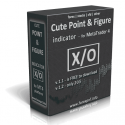While the actual formulas remain unchanged, indicators on P&F charts are calculated a little differently than indicators on bar charts. Instead of daily or weekly closing prices as the database, P&F charts use the average price of each column. Despite this difference, chartists can use these indicators much the same way as they are used on bar charts.
Moving averages on Point & Figure charts are based on the average price of each column. In contrast, bar chart moving averages are based on each period’s close. A 10-day SMA on a bar chart would be the average of the last ten closing prices. On a P&F chart, a 10-period SMA would be the average price of the last 10 column averages.
A 1-period SMA provides an easy example for starters. If an X-Column extends from 43 to 50, the 1-period SMA would be 46.5 {(43 + 50)/2 = 46.5}
A 5-period SMA on a P&F chart would be the column average for the last five columns.
Double smoothing means shorter moving averages can be used. Taking the average of the column smooths price once. A moving average greater than 2-period smooths price a second time. With P&F charts, a 5-period SMA is a 5-period SMA of a 1-period SMA. This double smoothing means chartists can use shorter moving averages with P&F charts. A 5-day SMA on a P&F chart may produce signals similar to a 50-day SMA on a bar chart.
There are at least three possible moving average signals. First, chartists can look for price to cross the moving average. A move above the moving average is bullish, while a move below the moving average is bearish. Second, chartists can identify the direction of the moving average. A rising moving average is bullish and a falling moving average is bearish. Third, chartists can use two moving averages to generate signals. A bull signal is triggered when the shorter moving average crosses above the longer moving average. A bear signal triggers when the shorter moving average crosses below the longer moving average.
Sources:
http://stockcharts.com


Newest comments